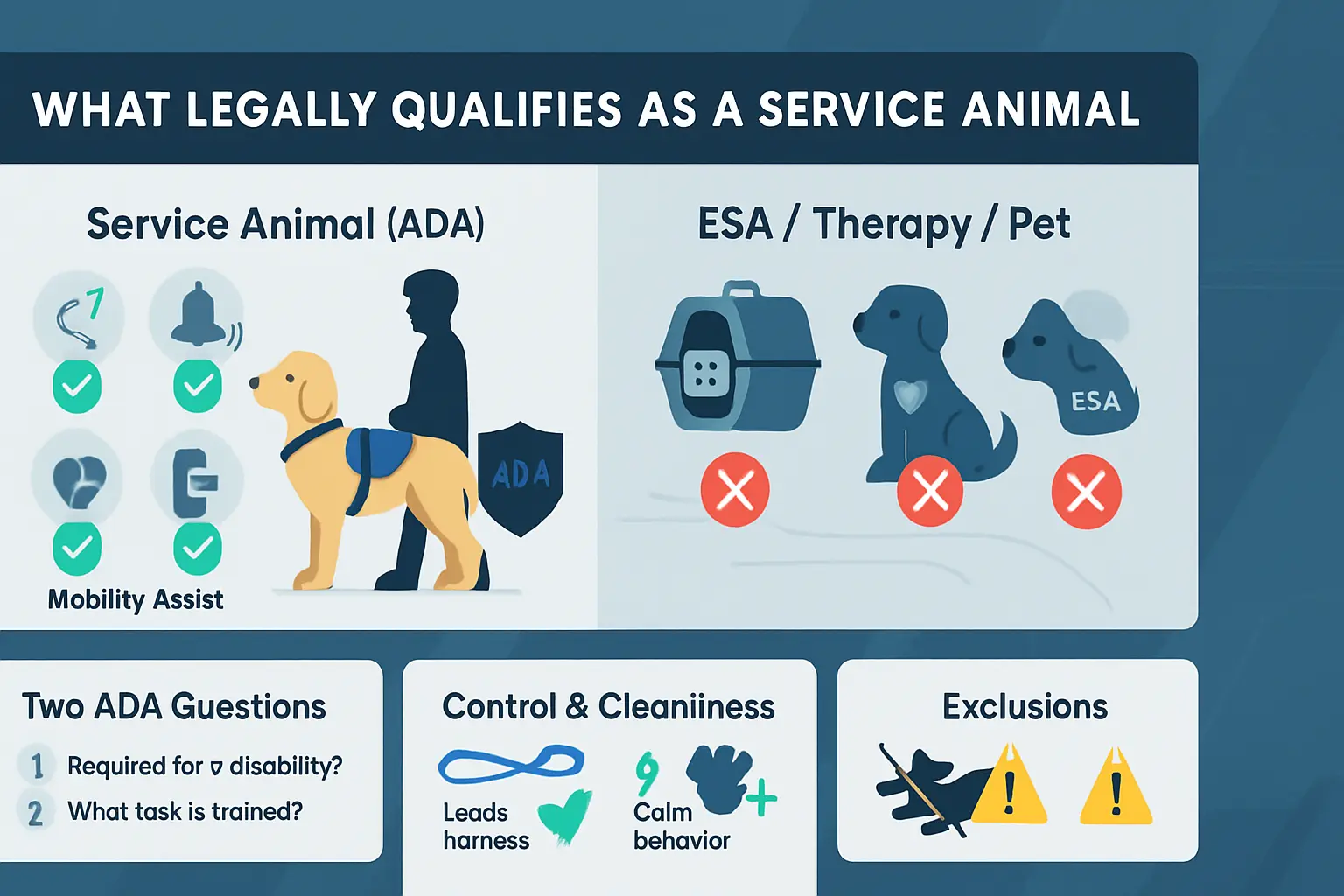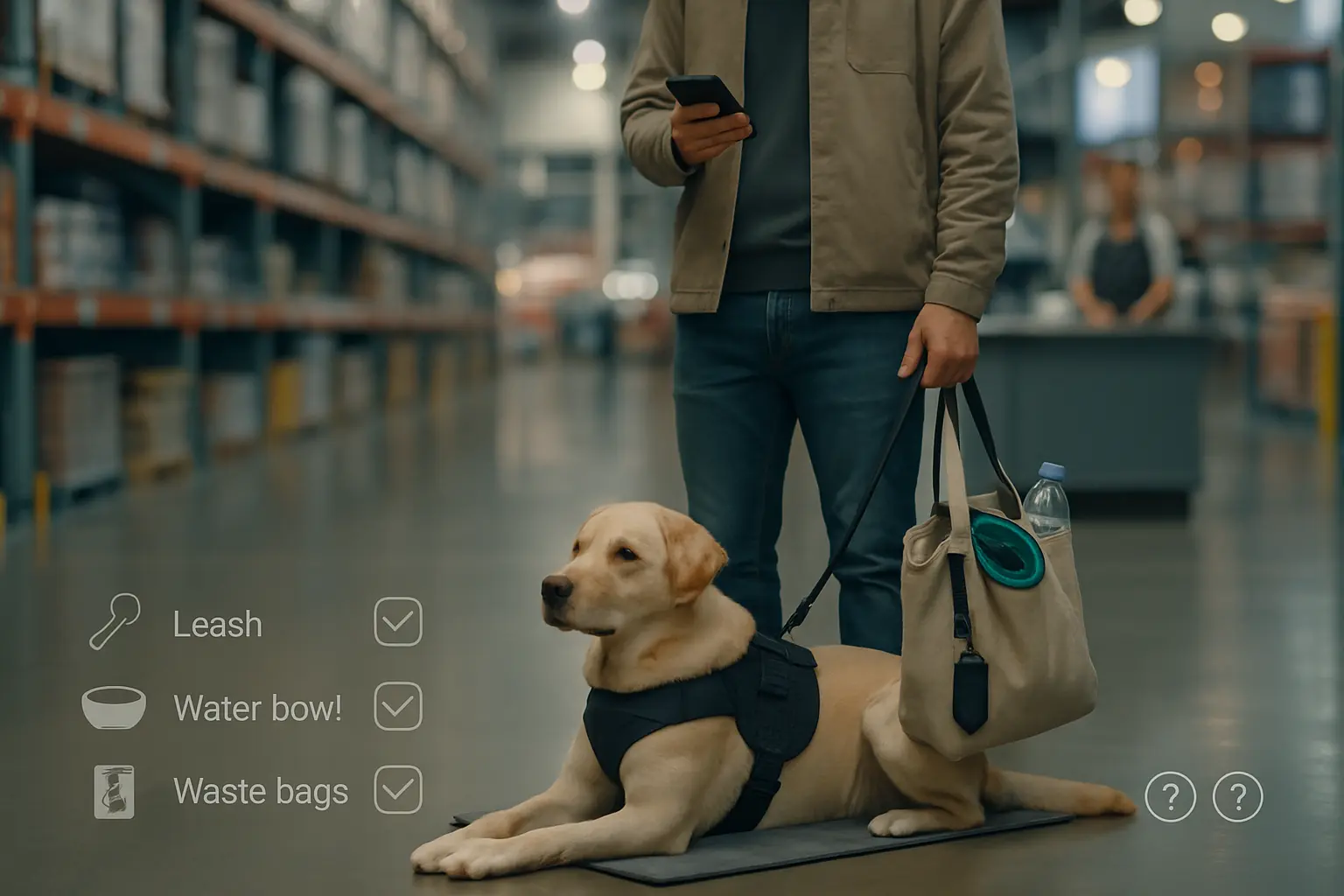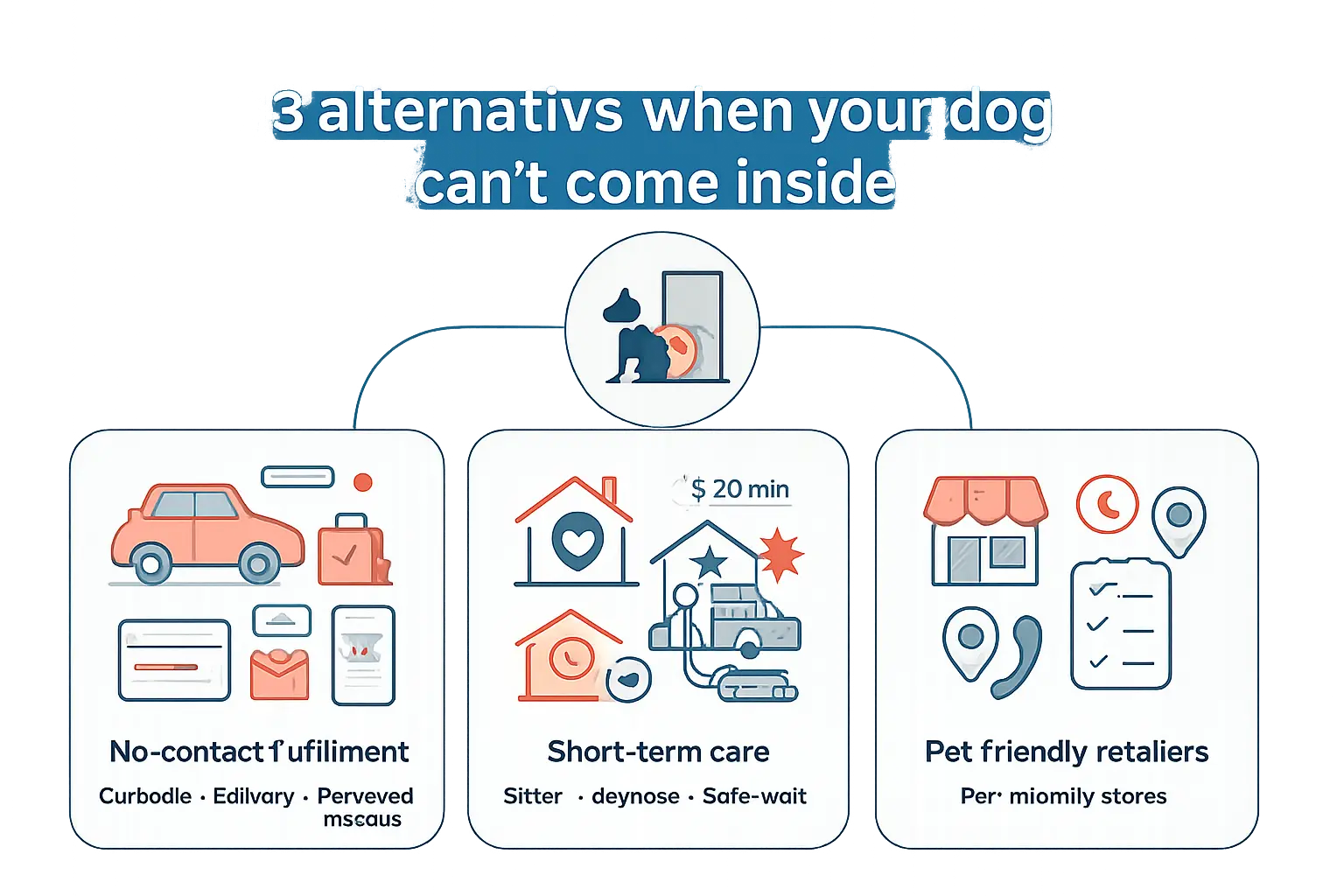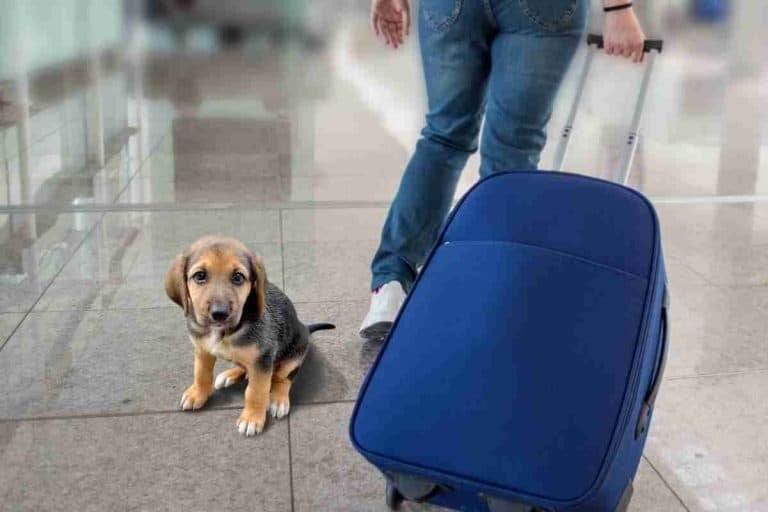Can You Bring Your Dog to Costco? Official Rules for Service Dogs, ESAs, and Pets
Last Updated on September 17, 2025
Can You Bring Your Dog to Costco? Official Rules for Service Dogs, ESAs, and Pets—usually, only trained service dogs may enter. Costco follows ADA guidelines. Pets and emotional support animals typically can’t go inside. Staff may ask two questions about service-dog status and tasks. Any dog must stay under control and be housebroken. Local health codes and manager discretion can affect access, especially near food areas.
Shoppers will learn how Costco enforces the no‑pets policy at the door, what to say when questioned, and how ADA rules apply. The guide also covers location-by-location differences, practical preparation and etiquette, alternatives like curbside pickup or delivery, and steps to take if a legitimate service dog is denied entry.
Quick answer — when a dog can enter Costco
Costco allows trained service dogs to accompany their handlers inside warehouses. Ordinary pets and emotional support animals (ESAs) do not qualify under the Americans with Disabilities Act and generally cannot enter. Stores may refuse animals that pose a direct threat, behave uncontrollably, or are not housebroken.
Service dogs must remain under control and not disrupt other shoppers. Local health codes sometimes restrict animals in food-preparation areas, but the ADA still requires access for service animals to most public areas. If a dog’s presence creates safety or sanitation hazards, store staff may ask the handler to remove the animal.
For a point of comparison with other retail policies, see Are dogs allowed in Cabelas? Shoppers should remember policies can vary by location and manager discretion. When unsure, calling the specific Costco warehouse before visiting avoids surprises and prevents conflicts at the door.
Bottom-line distinction: service animals versus pets
The critical legal difference centers on function. A service animal performs specific tasks for a person with a disability. Typical tasks include guiding, alerting, retrieving, or interrupting unsafe behaviors. The ADA defines service animals primarily as dogs, and certain entities also recognize trained miniature horses.
Emotional support animals provide comfort through presence. They lack task-based training that addresses a disability. Under federal ADA rules, ESAs do not receive the same public-access rights as service dogs. Misrepresenting a pet as a service animal can lead to removal from the store.
Employees may not demand medical proof or certifications. As mentioned earlier, staff can limit access if the animal is out of control or not housebroken. Rules differ across industries; for example, travel rules for bringing dogs on planes follow different standards, which can affect planning. See airlines that allow large dogs in cabin for industry contrasts.
What this means for ordinary shoppers
Shoppers who want to bring a non-service dog into Costco must plan alternative arrangements. Options include leaving the dog at home, using a pet sitter, or choosing curbside pickup and online ordering. Those alternatives avoid confrontation and protect the dog from crowded warehouse conditions.
If a shopper believes their animal qualifies as a service dog, they should calmly explain the situation to staff. Staff may still exclude animals that are aggressive, noisy, or unhygienic. If the store denies access improperly, the handler can request a manager or contact local ADA enforcement for clarification.
Practical preparation helps. Bring a leash and a crate or calming aids during short waits. For longer trips and shopping errands, consult general travel and handling tips to keep a dog safe and comfortable. For related advice on transporting and managing dogs during outings, see essential dog travel tips and gear for road trips. Call the local warehouse before visiting when policy or safety is uncertain.
Costco’s official stance on animals
Costco’s corporate policy aligns with federal disability law: it allows trained service animals into its warehouses while generally prohibiting household pets from sales floors. The company frames access around the Americans with Disabilities Act (ADA), which defines service animals and limits what staff may ask about them. At the same time, Costco enforces food-safety and sanitary rules that restrict animals in areas where food is handled or prepared.
Customers who wonder Can You Bring Your Dog to Costco? Official Rules for Service Dogs, ESAs, and Pets will find that Costco separates legal obligations from store-level rules. Service animals that perform specific tasks for a person with a disability can accompany their handler. Emotional support animals (ESAs), therapy animals, and regular pets normally do not meet that standard and therefore face the same restrictions as other animals.
For context on how large retailers craft animal policies, see Are dogs allowed in Cabelas. That comparison helps explain why Costco applies a clear service-animal exception while keeping a firm no-pets rule on the sales floor.
What the company policy says about service animals
Costco recognizes service animals as defined by the ADA. Store employees may ask only two questions: whether the animal is a service animal required because of a disability, and what work or task the animal is trained to perform. Employees may not demand documentation, require the dog to demonstrate tasks, or ask about the customer’s disability.
Handlers must keep the animal under control. Leashes, harnesses, or voice commands are acceptable. If an animal becomes disruptive, poses a direct threat, or is out of control, staff can ask the handler to remove it. Costco expects staff to balance legal compliance with safety and cleanliness for all shoppers.
Many travel and transport providers follow similar protocols. For a look at how other industries handle animals and service-dog rules, consult Airlines that allow large dogs in cabin. That resource highlights common verification limits and control expectations across public-facing businesses.
Rules for emotional support animals and household pets
Costco treats emotional support animals and household pets differently from service animals. ESAs do not qualify as service animals under the ADA unless trained to perform a specific task for a disability. As a result, ESAs face the same restrictions as pets at Costco warehouses.
Most warehouses prohibit pets on the sales floor and in food-service areas to comply with health codes and maintain cleanliness. Exceptions sometimes exist for outdoor garden centers or special events, but those exceptions vary by location. Bringing an ESA without documented task training risks denial of entry.
Customers who need alternatives can use curbside pickup, delivery, or have someone shop on their behalf. For practical tips on transporting and managing a dog when errands require leaving pets behind, see Essential dog travel tips and gear for road trips. Those suggestions help plan safe, comfortable options when a pet cannot enter a store.
How individual warehouses may apply the policy differently
Local warehouses implement Costco’s corporate policy through site-level rules and manager discretion. Differences can arise from state or municipal health laws, warehouse layout, and local risk assessments. For example, some locations allow pets in outdoor garden areas while others prohibit them entirely.
Warehouse managers handle incidents case-by-case. A well-behaved, leashed service dog normally gains entry. However, if a local health code restricts animals near fresh food, staff may limit access to certain aisles or ask the handler to use another entrance. Managers also set enforcement style—some staff apply the policy strictly, others use a more lenient approach.
Before visiting, customers should call their local warehouse or check its official contact page. Calling ahead clarifies whether a specific location makes exceptions or enforces particular limits. For insight on how different venues treat animal access and practical planning, consult Traveling with your dog by train: tips and tricks. The post illustrates how rules vary across operators and why confirming ahead saves time.
What legally qualifies as a service animal

The Americans with Disabilities Act (ADA) narrows the legal definition of a service animal to animals individually trained to perform tasks for a person with a disability. The law focuses on the animal’s function, not the disability. Common lawful examples include guide dogs for people who are blind, hearing dogs for people who are deaf, and mobility-assistance dogs that retrieve items or open doors.
The ADA generally recognizes dogs, and under specific conditions, miniature horses. Animals whose primary role is emotional support or companionship do not qualify under the ADA. Public accommodations, such as retail stores, must permit qualified service animals to accompany their handlers in all areas open to the public.
Stores may impose rules based on health or safety risks, and they can exclude a service animal if it is out of control or not housebroken. For travel contexts and other transport-related rules, see guidance about airlines that allow large dogs in cabin, which shows how different sectors apply distinct standards.
ADA definition and common examples
The ADA’s definition centers on task-trained animals. A service dog must perform a work or task directly related to a person’s disability. Examples clarify the boundary between genuine service animals and pets.
Typical ADA examples include:
- Guide dogs that lead a person who is blind around obstacles.
- Hearing dogs that alert a deaf person to doorbells or alarms.
- Medical-alert dogs that detect oncoming seizures or drops in blood sugar.
- Mobility-assistance dogs that brace to help a person stand or retrieve dropped items.
Miniature horses may qualify when they meet stability, training, and facility-fit criteria. The emphasis remains on observable tasks that mitigate a disability. For practical travel-related examples of permitted dogs, readers can consult dogs you can take on a plane, which illustrates how types of working dogs appear in transit settings.
How psychiatric service animals, therapy dogs, and ESAs differ
Psychiatric service animals (PSAs), therapy dogs, and emotional support animals (ESAs) serve different roles and have different legal standings. A PSA performs active tasks that directly reduce psychiatric disability symptoms. Examples include interrupting self-harm behaviors, reminding to take medication, or providing deep-pressure therapy during panic attacks.
Therapy dogs provide comfort to many people in settings like hospitals or schools. They are trained for social interaction, not to perform disability-related tasks. ESAs provide emotional comfort to a specific individual and usually lack task training. Under the ADA, neither therapy dogs nor ESAs qualify as service animals.
Because behavior and training determine access rights, handlers of PSAs should ensure clear, task-based descriptions when asserting ADA protections. For owners exploring non-legal support methods, resources on natural ways to remedy a dog’s travel anxiety may offer complementary strategies to improve animal behavior and public interactions.
Identification, certification myths, and the limits of staff questioning
Many assume a service animal must wear a vest or carry certification. The ADA does not require identification, registration, or certification for a service animal. Businesses cannot demand documentation showing the animal’s training or proof of disability.
Staff may ask only two questions when the disability or task is not obvious: (1) Is the animal required because of a disability? and (2) What work or task has the animal been trained to perform? Staff cannot ask about the person’s disability, require medical records, or demand a demonstration of the task.
An animal may be excluded if it is disruptive, aggressive, or not housebroken. Facilities may set reasonable, uniformly applied rules for control and sanitation. For how stores handle pet policies and exceptions in retail settings, see are dogs allowed in Cabela’s. If a customer faces improper questioning or denial, the recommended action is to request to speak with a manager and, when necessary, contact local disability rights authorities or consult legal guidance.
Can You Bring Your Dog to Costco? Official Rules for Service Dogs, ESAs, and Pets
How Costco enforces the rule and what to expect at the door
Costco enforces its no-pets policy through visible signage and staff at main entrances. Employees will screen animals before entry to protect food safety and member comfort. Expect staff to stop members briefly, especially near food samples, cafes, or fresh-produce areas. Service dogs trained to perform tasks for a person with a disability receive different treatment under federal rules, but stores still monitor behavior and hygiene.
Retailers vary on pet access; some allow pets in certain areas or at the manager’s discretion. For a comparison of how other large retailers handle pets, see Are dogs allowed in Cabela’s? This can help set realistic expectations about enforcement at big-box entrances.
Questions employees may legally ask and what you should answer
Employees may ask only limited questions about an animal’s status. They can ask if the animal is a service animal required because of a disability. They may ask what specific task the animal is trained to perform. Staff cannot demand documentation, proof of training, or require the person to demonstrate the task.
Answer clearly and briefly. State that the dog is a service animal and name the task it performs, for example, “alerts to seizures” or “provides balance assistance.” Avoid offering extra details about the disability. If the animal’s behavior is disruptive—barking, lunging, or soiling—employees may ask that it be removed, regardless of status.
For general tips on traveling with dogs and reducing door-side issues, consult resources like traveling with your dog by train tips and tricks.
Possible outcomes if a dog is refused entry
If staff refuse entry, outcomes vary. They may ask the dog to be removed from the store area but allow the handler to remain. They may offer alternative service options, such as curbside pickup, home delivery, or having another household member wait outside with the pet. In more contentious cases, management may be called to review the situation.
Handlers should remain calm and request options. Calling member services or using the store’s pickup services avoids confrontation. If the dog presents a genuine safety or sanitation risk, the store can insist on removal for all customers’ protection.
For practical alternatives and safe short-term arrangements, see essential dog travel tips and gear for road trips. A simple CTA: call the specific Costco ahead to confirm their entry policy before visiting with any animal.
Role of store management and local health or safety rules
Store managers hold discretion to enforce corporate policy and local health codes. They can override floor staff decisions when appropriate and must balance ADA obligations with health regulations. If an animal enters a restricted area, management may contact local health or safety authorities for guidance.
Local public-health ordinances can impose stricter limits than corporate rules. For example, state or county rules about animals near food prep areas may require immediate removal. Management will act to comply with those rules and to avoid citations.
If a handler believes a service dog was wrongly denied, request manager review and note the manager’s name. Escalation paths include member services or, when applicable, legal guidance about service-animal rights. For insights into how regulated carriers handle animal documentation and safety, see airlines that allow large dogs in cabin.
Practical preparation and in‑store etiquette for service dogs

When handlers consult guidance under the title Can You Bring Your Dog to Costco? Official Rules for Service Dogs, ESAs, and Pets, preparation matters more than paperwork alone. Confirm the retailer’s policy before arrival and have a clear plan for safe, efficient navigation inside the store. A calm, well-groomed service dog reduces questions from staff and other shoppers. Pack a small kit with water, a bowl, waste bags, a spare leash, and a mat to anchor the dog near displays. Map a route through wide aisles to avoid congestion and note where sample stations and checkout lanes typically cluster. If the store posts designated entrances for service animals, use them. Train the dog to wait quietly near the handler’s feet and to ignore food displays. Bring any identification or documentation the handler prefers to carry, but remember that under federal law, businesses may only ask limited questions about whether the dog is a service animal and what tasks it performs. Keep interactions polite and brief if staff need clarification. These steps help ensure compliance with store rules while maintaining a low profile on busy shopping days.
Training, leash, grooming, and necessary supplies
Handlers should prioritize task-focused training so the dog remains steady amid crowds. Obedience for sit, down, stay, and heel makes moving through aisles predictable. Use a secure, comfortable harness rather than a retractable leash; it gives control without pulling. Grooming reduces loose hair on carts and displays; a quick brush before leaving home minimizes shedding. Pack these essentials: a sturdy leash and harness, a collapsible water bowl, bottled water, waste bags, a small towel, and a calming chew or toy used only in public. For long visits, include a compact mat so the dog has a defined place to rest near the handler. For road-trip and shopping logistics, handlers can consult resources on travel gear; a relevant reference is essential dog travel tips and gear. Regularly practicing brief public outings conditions the dog to shop behavior, reducing disruptions and making in-store visits smoother for everyone.
Navigating busy aisles, sample stations, and carts
Plan routes to avoid high-traffic spots during peak sample times. Move along the outer perimeter when possible; aisles near food demos attract lingering shoppers. Keep a close right-side position and maintain a compact footprint so the dog does not block shelves or carts. If a product sample draws a crowd, step back and wait for the area to clear before proceeding. Avoid placing the dog on or near shopping carts; many customers and staff find it intrusive. When encountering displays that protrude into the walkway, pivot the dog to heel and advance slowly. If a shopper approaches with curiosity, the handler should signal a brief pause and continue moving once the interaction concludes. For additional store-policy context about animals in retail spaces, handlers may review similar store rules such as those at are dogs allowed in Cabela’s. Consistent pacing and proactive spacing prevent congestion and reduce the chance of a complaint.
Handling customer interactions and complaints calmly
Train the handler to use calm, assertive language when questioned. Offer a polite, concise explanation that the dog is a working service animal and describe the task it performs if asked. Under federal guidance, staff may ask two simple questions only; avoid volunteering medical details. If a customer objects, the handler should maintain distance and de‑escalate by moving away from the complainant and into a less crowded aisle. If staff insist on further verification, request to speak with management and remain composed while presenting any voluntary identification. When a complaint escalates, document names, time, and what occurred; this aids follow-up with store management later. Training the dog to remain neutral around people minimizes incidents. For strategies to reduce anxiety-driven reactions that often spark complaints, handlers can reference practical calming techniques such as natural ways to remedy a dog’s travel anxiety. If uncertainty persists, call the store ahead or ask for a manager before entering. This proactive step prevents conflicts and keeps shopping runs efficient.
Common scenarios and concise FAQs
Costco limits animals in warehouses to federally defined service animals. Members should verify local rules before arriving. Call the warehouse or check Costco’s official site when unsure.
Are small dogs, carriers, or dogs in bags allowed?
Costco does not allow pets inside warehouses unless they qualify as service animals under the ADA. Bringing a small dog in a carrier, bag, or stroller does not change that rule. Employees may ask only two questions if an animal appears to be a service animal: whether it is required because of a disability and what tasks it is trained to perform. Emotional support animals and pets do not meet that definition and can be denied entry. For short trips, consider leaving a pet at home, using pet daycare, or using a trusted sitter.
Can dogs accompany you at Costco gas stations, food courts, or sample areas?
Policies vary by location and local health codes. Many gas stations and outdoor areas permit pets on a leash, but food courts and indoor sampling areas generally fall under stricter health rules. Staff may ask that animals remain in vehicles or be left at home when local regulations prohibit them. When in doubt, ask staff before entering those areas.
Differences in policy for Costco locations abroad
International Costco locations follow local laws and health codes, which can differ substantially from U.S. ADA rules. Some countries allow pets in outdoor and retail spaces more freely. Others enforce strict bans similar to U.S. warehouses. For examples of how retail chains handle pet policies in different regions, see Are dogs allowed in Cabela’s? Contact the specific international warehouse before traveling with an animal.
Alternatives when your dog can’t come inside

When a store denies pets, shoppers need practical alternatives that protect the dog and preserve the shopping plan. Options fall into three categories: no-contact fulfillment, short-term care near the store, and switching to pet-friendly retailers. No-contact fulfillment covers curbside pickup, home delivery, and hiring personal shoppers. Short-term care includes quick pet sitters, in-car safety solutions, and kennel services for longer trips. Choosing the best approach depends on the dog’s size, temperament, and the length of the visit. For drivers, packing secure gear and water reduces stress for a waiting dog. For shoppers who travel with pets often, a checklist of safety items helps avoid last-minute problems; useful advice appears in this essential dog travel tips and gear for road trips. Businesses change policies quickly, so checking the retailer’s website or app before arrival prevents surprises. Each alternative has trade-offs in time, cost, and convenience. The three subsections that follow explain how to choose and execute these options without putting the dog or the shopper at risk.
Curbside pickup, home delivery, and personal shoppers
Curbside pickup eliminates the need to leave a dog unattended in a vehicle. Many warehouse stores offer same-day or scheduled pickup through their apps. Home delivery removes the issue entirely, though fees and delivery windows vary. Personal shoppers or concierge services pick and deliver items for a fee and can be ideal when the dog cannot wait in a car. For each option, confirm the store’s timelines and payment methods before placing an order. If the dog travels in the car during pickup, secure the animal with appropriate restraints and ventilation. Guidance on safe in-car restraint options can help; see this post about how to secure a dog in car with leash. When using delivery services, communicate any building access instructions and where the driver can safely leave packages. A final tip: sign up for text or app notifications so the shopper or driver waits only the necessary minutes, reducing the dog’s time alone.
Short-term pet care options for shopping trips
Short errands may require quick, reliable pet care. Local options include drop-in pet sitters, hourly dog walkers, and professionally staffed pet hotels near shopping centers. For visits under 30 minutes, trusted neighbors or two-way video monitoring with a short-term check-in often suffice. For longer trips, a dog-friendly daycare or boarding facility provides supervised care and exercise. When selecting a sitter, verify references, vaccination requirements, and insurance. If leaving a dog in a car is unavoidable, never leave them unattended in warm or hot weather. Equip the vehicle with shade, fresh water, and a temperature monitor. For travel-oriented crate and containment solutions, consider models reviewed in this best dog crates for car travel in 2023. Always plan drop-off and pick-up windows to minimize wait time and reduce anxiety for the dog.
Other pet-friendly retailers and how they compare
Some retailers welcome pets on the sales floor, creating an easy alternative to stores with strict no-pet rules. Big-box outdoor and sporting goods chains frequently allow dogs, depending on store policy and local health codes. When comparing options, look at leash rules, breed restrictions, and whether handler masks or muzzles are required. Stores that allow pets often provide clearer signage and indoor relief areas. For a quick comparison to a well-known outdoor retailer’s policy, see this discussion on are dogs allowed in Cabela’s. Choose pet-friendly retailers for routine shopping that includes the dog. For specialty or large-item purchases, verify return policies and measurement procedures before buying. A shopping strategy that combines pet-friendly stores with curbside or delivery services solves most conflicts between store rules and pet ownership. Consider calling stores ahead to confirm current pet policies and avoid surprises at the door.
If you believe your service dog was wrongly denied: next steps
When a store denies access to a service dog, the person affected should act quickly and methodically. First, remain calm and request the manager. Ask the staff to state the reason for denial and to provide the manager’s name. If staff cite safety or store policy, request that explanation in writing or ask the manager to make a short written note of what was said.
Document the scene immediately: note the time, location, staff names, and any witnesses. Take photos or short video that show the dog, the environment, and any signage that might support or contradict the staff’s claim. If a witness offers contact details, collect them.
Next, escalate through Costco’s channels. File an incident report with store management and follow up with Costco’s customer service. If the denial involves clear discrimination against a person with a disability, filing with the U.S. Department of Justice’s ADA enforcement is appropriate.
Retail polices vary by chain. For context on how national retailers handle pets and service animals, see Are dogs allowed in Cabela’s? This can help frame expectations when discussing the issue with store management.
How to document the incident and file a complaint
Accurate documentation strengthens any complaint. Create a concise written timeline of events while details remain fresh. Include date, time, store address, names of employees, and the manager’s response. Attach photos or video and copies of receipts or membership cards that show presence in the store.
Collect witness statements. Ask witnesses to write a short account and sign it, or to provide a phone number or email for follow-up. Preserve any written materials staff gave, including printed policies or a written denial.
Send a formal complaint to Costco’s customer service by email and, if available, by certified mail. Keep copies of all correspondence. When filing with ADA authorities, include the timeline, attachments, and contact details. If the incident involved disruptive behavior or threats, report it to local law enforcement and include the police report number in the complaint.
For guidance on documenting animal-related incidents and preparing evidence, review What happens if my dog barks on a plane? It offers examples of useful documentation for behavioral incidents.
Contact points: Costco customer service, ADA offices, and local authorities
Begin with the store’s management and Costco’s corporate customer service. Costco provides member services and a corporate customer support channel for escalations. Ask for a case or reference number when filing a complaint.
For civil rights complaints, contact the U.S. Department of Justice’s Civil Rights Division — Disability Rights Section. File an ADA complaint online or via mail to the regional office. State and local disability rights agencies can also accept complaints and provide advocacy.
If the incident included threats, physical altercation, or safety concerns, contact local law enforcement immediately and obtain a police report. Keep the report number and officer name for complaint filings.
For related policy comparisons and to understand how other large retailers manage animals, see Airlines that allow large dogs in cabin. While that post covers travel rules, it illustrates how organizations publish and enforce animal policies and how to approach enforcement disputes.
Resources for legitimate training, certification, and legal guidance
Understand that ADA law does not require formal certification for service dogs. Legitimate resources focus on training, behavior, and legal protection rather than selling a certificate. Seek accredited trainers, nonprofit service-dog programs, and positive-reinforcement behaviorists.
Avoid online “registration” services that claim to certify a service animal for public access. These documents carry no legal weight under the ADA. Instead, consult recognized sources: national disability rights organizations, ADA.gov guidance, and reputable dog-training associations.
For behavioral support that improves public access outcomes, consult trainers and resources that address travel and public behavior. Practical behavior techniques and anxiety remedies help reduce situations that trigger denial. See 9 natural ways to remedy your dog’s travel anxiety for approaches that reduce stress-related incidents.
If the situation may require legal action, refer the person to a disability-rights attorney or local legal aid. A qualified attorney can advise on remedies, damages, and procedural steps for ADA or state-law claims. Request documentation and witness contact information before consulting counsel to preserve evidence for legal review.
Summary
Costco permits only ADA-defined, task-trained service dogs in its warehouses; pets and emotional support animals (ESAs) are generally not allowed. Employees may ask just two questions about a service dog’s status and tasks, and they can require removal if an animal is disruptive or not housebroken. Local health codes and manager discretion influence enforcement, especially near food preparation and sampling areas.
Shoppers can avoid conflicts by calling the specific warehouse ahead, preparing a well-controlled service dog for busy aisles, and using alternatives—curbside pickup, delivery, or short-term pet care—when a dog cannot enter. If a legitimate service dog is wrongly denied, document the incident, request a manager review, and escalate through Costco customer service or ADA channels.
Key Takeaways
- Only ADA-trained service dogs (and in limited cases, miniature horses) may enter Costco; ESAs and pets do not qualify.
- Staff may ask only two questions about service status and tasks; no documentation or task demonstration is required.
- Stores may exclude any animal that is aggressive, disruptive, or not housebroken, and health codes can limit access near food areas.
- Policies vary by warehouse and local law; calling ahead prevents surprises and speeds entry.
- Use alternatives when dogs can’t enter: curbside pickup, delivery, or vetted short-term pet care.
- If a service dog is wrongly denied, request a manager, document details, and file complaints with Costco and ADA authorities.
FAQ
What dogs are allowed in Costco?
Costco admits only ADA-defined, task-trained service dogs accompanying a person with a disability. Emotional support animals and household pets are generally not allowed.
How can employees verify a service dog?
Staff may ask if the animal is required because of a disability and what task it is trained to perform. They cannot demand papers, ID, or a task demonstration.
What happens if a service dog misbehaves in the store?
Employees can require removal if the animal is disruptive, poses a direct threat, or is not housebroken. The handler may continue shopping without the animal when feasible.
How should handlers prepare for a Costco visit with a service dog?
Keep the dog leashed or harnessed, groomed, and under reliable control; bring water, waste bags, and a mat. Plan routes to avoid crowded sample stations and narrow aisles.
Why call the warehouse before bringing a dog?
Local health codes and manager discretion can affect access and enforcement. A quick call confirms any site-specific rules, saving time at the entrance.







